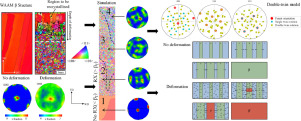当前位置:
X-MOL 学术
›
Acta Mater.
›
论文详情
Our official English website, www.x-mol.net, welcomes your
feedback! (Note: you will need to create a separate account there.)
On the Observation of Annealing Twins during Simulating β-Grain Refinement in Ti-6Al-4V High Deposition Rate AM with In-Process Deformation
Acta Materialia ( IF 8.3 ) Pub Date : 2020-03-01 , DOI: 10.1016/j.actamat.2020.01.009 J. Donoghue , A.E. Davis , C.S. Daniel , A. Garner , F. Martina , J. Quinta da Fonseca , P.B. Prangnell
Acta Materialia ( IF 8.3 ) Pub Date : 2020-03-01 , DOI: 10.1016/j.actamat.2020.01.009 J. Donoghue , A.E. Davis , C.S. Daniel , A. Garner , F. Martina , J. Quinta da Fonseca , P.B. Prangnell

|
Abstract Additive Manufacture (AM) of Ti–6Al–4V frequently leads to undesirable, coarse, columnar β-grain structures with a strong fibre texture. In Wire-Arc AM (WAAM), it has been found that the application of a low plastic strain, by methods such as inter-pass rolling, can disrupt β columnar growth and produce a refined, equiaxed grain structure that is more randomly orientated. The origin of this desirable effect has been investigated by thermo-mechanical simulation, direct in-situ EBSD observation, as well as by real-time synchrotron X-ray diffraction (SXRD) during rapid heating. These complementary approaches have shown that, when starting with a WAAM microstructure, the grain refinement process produces a unique micro-texture represented by a four-pole motif symmetrically centred on the parent grain {100} orientations. These new β-grain orientations can be reproduced by a double {112} twinning operation, which produces 12 new, unique, β-orientation variants. High-resolution orientation-mapping techniques and in-situ SXRD heating simulations suggest that the prior β does not twin during deformation, but rather the grain refinement and related texture may be caused by annealing twinning during β re-growth on rapid re-heating of the deformed AM microstructure. Although this is the first time such a unique texture has been observed in a deformed and β annealed Ti–6Al–4V material, it was only found to dominate under the unusual conditions that occur in AM of rapid heating – a fine, lightly deformed α transformation microstructure, with a very coarse starting β-grain structure.
中文翻译:

在 Ti-6Al-4V 高沉积速率 AM 中模拟 β 晶粒细化过程中退火孪晶的观察和过程变形
摘要 Ti-6Al-4V 的增材制造 (AM) 经常会导致不良的、粗糙的、柱状 β 晶粒结构和强烈的纤维质地。在线弧增材制造 (WAAM) 中,已经发现通过道间轧制等方法应用低塑性应变可以破坏 β 柱状生长并产生更随机取向的细化等轴晶粒结构。通过热机械模拟、直接原位 EBSD 观察以及快速加热过程中的实时同步辐射 X 射线衍射 (SXRD) 研究了这种理想效应的起源。这些互补的方法表明,当从 WAAM 微观结构开始时,晶粒细化过程会产生独特的微观纹理,由以母体晶粒 {100} 取向为中心对称的四极图案表示。这些新的 β 晶粒取向可以通过双 {112} 孪晶操作重现,该操作产生 12 种新的、独特的 β 取向变体。高分辨率取向映射技术和原位 SXRD 加热模拟表明,先验 β 在变形过程中不会孪晶,而是晶粒细化和相关织构可能是由 β 再生长过程中的退火孪晶引起的。变形的 AM 微观结构。尽管这是第一次在变形和 β 退火的 Ti-6Al-4V 材料中观察到这种独特的织构,但仅在快速加热的 AM 中出现的异常条件下才发现这种织构占主导地位——一种精细的、轻微变形的 α转变微观结构,具有非常粗的起始 β 晶粒结构。独特的 β 方向变体。高分辨率取向映射技术和原位 SXRD 加热模拟表明,先验 β 在变形过程中不会孪晶,而是晶粒细化和相关织构可能是由 β 再生长过程中的退火孪晶引起的。变形的 AM 微观结构。尽管这是第一次在变形和 β 退火的 Ti-6Al-4V 材料中观察到这种独特的织构,但仅在快速加热的 AM 中出现的异常条件下才发现这种织构占主导地位——一种精细的、轻微变形的 α转变微观结构,具有非常粗的起始 β 晶粒结构。独特的 β 方向变体。高分辨率取向映射技术和原位 SXRD 加热模拟表明,先验 β 在变形过程中不会孪晶,而是晶粒细化和相关织构可能是由 β 再生长过程中的退火孪晶引起的。变形的 AM 微观结构。尽管这是第一次在变形和 β 退火的 Ti-6Al-4V 材料中观察到这种独特的织构,但仅在快速加热的 AM 中出现的异常条件下才发现这种织构占主导地位——一种精细的、轻微变形的 α转变微观结构,具有非常粗的起始 β 晶粒结构。而是晶粒细化和相关的织构可能是由变形的 AM 微观结构的快速再加热过程中 β 再生长过程中的退火孪晶引起的。尽管这是第一次在变形和 β 退火的 Ti-6Al-4V 材料中观察到这种独特的织构,但仅在快速加热的 AM 中出现的异常条件下才发现这种织构占主导地位——一种精细的、轻微变形的 α转变微观结构,具有非常粗的起始 β 晶粒结构。而是晶粒细化和相关的织构可能是由变形的 AM 微观结构的快速再加热过程中 β 再生长过程中的退火孪晶引起的。尽管这是第一次在变形和 β 退火的 Ti-6Al-4V 材料中观察到这种独特的织构,但仅在快速加热的 AM 中出现的异常条件下才发现这种织构占主导地位——一种精细的、轻微变形的 α转变微观结构,具有非常粗的起始 β 晶粒结构。
更新日期:2020-03-01
中文翻译:

在 Ti-6Al-4V 高沉积速率 AM 中模拟 β 晶粒细化过程中退火孪晶的观察和过程变形
摘要 Ti-6Al-4V 的增材制造 (AM) 经常会导致不良的、粗糙的、柱状 β 晶粒结构和强烈的纤维质地。在线弧增材制造 (WAAM) 中,已经发现通过道间轧制等方法应用低塑性应变可以破坏 β 柱状生长并产生更随机取向的细化等轴晶粒结构。通过热机械模拟、直接原位 EBSD 观察以及快速加热过程中的实时同步辐射 X 射线衍射 (SXRD) 研究了这种理想效应的起源。这些互补的方法表明,当从 WAAM 微观结构开始时,晶粒细化过程会产生独特的微观纹理,由以母体晶粒 {100} 取向为中心对称的四极图案表示。这些新的 β 晶粒取向可以通过双 {112} 孪晶操作重现,该操作产生 12 种新的、独特的 β 取向变体。高分辨率取向映射技术和原位 SXRD 加热模拟表明,先验 β 在变形过程中不会孪晶,而是晶粒细化和相关织构可能是由 β 再生长过程中的退火孪晶引起的。变形的 AM 微观结构。尽管这是第一次在变形和 β 退火的 Ti-6Al-4V 材料中观察到这种独特的织构,但仅在快速加热的 AM 中出现的异常条件下才发现这种织构占主导地位——一种精细的、轻微变形的 α转变微观结构,具有非常粗的起始 β 晶粒结构。独特的 β 方向变体。高分辨率取向映射技术和原位 SXRD 加热模拟表明,先验 β 在变形过程中不会孪晶,而是晶粒细化和相关织构可能是由 β 再生长过程中的退火孪晶引起的。变形的 AM 微观结构。尽管这是第一次在变形和 β 退火的 Ti-6Al-4V 材料中观察到这种独特的织构,但仅在快速加热的 AM 中出现的异常条件下才发现这种织构占主导地位——一种精细的、轻微变形的 α转变微观结构,具有非常粗的起始 β 晶粒结构。独特的 β 方向变体。高分辨率取向映射技术和原位 SXRD 加热模拟表明,先验 β 在变形过程中不会孪晶,而是晶粒细化和相关织构可能是由 β 再生长过程中的退火孪晶引起的。变形的 AM 微观结构。尽管这是第一次在变形和 β 退火的 Ti-6Al-4V 材料中观察到这种独特的织构,但仅在快速加热的 AM 中出现的异常条件下才发现这种织构占主导地位——一种精细的、轻微变形的 α转变微观结构,具有非常粗的起始 β 晶粒结构。而是晶粒细化和相关的织构可能是由变形的 AM 微观结构的快速再加热过程中 β 再生长过程中的退火孪晶引起的。尽管这是第一次在变形和 β 退火的 Ti-6Al-4V 材料中观察到这种独特的织构,但仅在快速加热的 AM 中出现的异常条件下才发现这种织构占主导地位——一种精细的、轻微变形的 α转变微观结构,具有非常粗的起始 β 晶粒结构。而是晶粒细化和相关的织构可能是由变形的 AM 微观结构的快速再加热过程中 β 再生长过程中的退火孪晶引起的。尽管这是第一次在变形和 β 退火的 Ti-6Al-4V 材料中观察到这种独特的织构,但仅在快速加热的 AM 中出现的异常条件下才发现这种织构占主导地位——一种精细的、轻微变形的 α转变微观结构,具有非常粗的起始 β 晶粒结构。











































 京公网安备 11010802027423号
京公网安备 11010802027423号